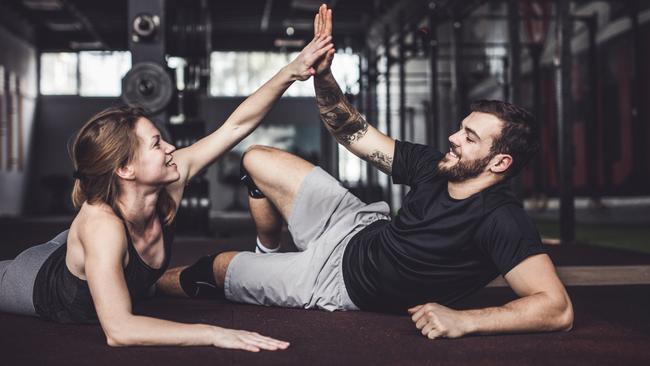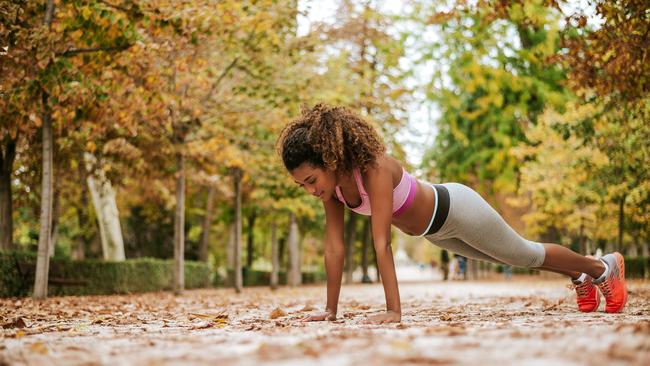Six tricks to make yourself exercise
Humans are programmed to avoid anything beyond the minimum level of physical effort, but one brain expert — using herself as a guinea pig — has found a way to override evolution.

When it’s cold and dreary, how do you convince yourself to go to the gym or exercise outdoors? Overcoming the many mental barriers to physical activity is an area of expertise for Jennifer Heisz, associate professor in kinesiology and director of the NeuroFit Lab she founded at McMaster University in Canada. Her work focuses on studying the intricate mechanics of the brain in response to physical activity yet, despite her academic prowess, Heisz was a reluctant exerciser.

“Like most people I struggled to find my footing with exercise,” she says. “There are many times I have to battle with myself to get out. If I am tired and stressed or just feel crappy, it’s not easy getting out of the door.”
If that sounds familiar, you’re not unusual — we are programmed to avoid anything beyond the minimum level of physical effort needed to get through the day, she says. “From an evolutionary perspective we needed to conserve energy for hunting and so the brain learnt to make us lazy at other times. Today that works against us in our resolutions to be more active. We don’t need to hunt for food to survive any more and so we are permanently struggling to overcome that urge to relax and recover.”
Four year ago Heisz served as her own guinea pig as she sought to overcome the urge to be a couch potato and progress from sedentary university professor to triathlete. In her new book Move the Body, Heal the Mind she documents her attempt to train for and compete in an Ironman race comprising a 2.4-mile swim, a 112-mile bicycle ride and a 26.2-mile run. That she was on the brink of divorce only added to the challenge, and what started as a semi-scientific experiment ended with her learning as much about herself as she did about the psychology of overcoming the innate impulse to be inactive.
In the end the Ironman event was called off because of the pandemic, so Heisz competed against herself in her own version of the race. The 13 hours and 10 minutes it took her to reach her finish line marked the end of a journey that she says changed her life for the better. “I developed strategies to keep going when I didn’t want to and through that I gained the mental toughness I needed to survive the next decade of my life. I’ve learnt not only how to keep going with exercise but how exercise can improve my body and my mind.”
If you struggle with motivation, here are her top tips for getting out of the door.
Swill your mouth with a sugary drink
One of Heisz’s tricks is to swish a sugary solution, such as a sports drink or even diluted maple syrup, in her mouth without swallowing it before she exercises. Why? Because it tricks the brain into thinking the body is about to get a jolt of energy. “With a false promise of sugar and a signal that energy reserves are plentiful, the brain starts to release dopamine so that we then are primed to get going,” she says.
University of Birmingham researchers discovered that “mouth-rinsing” for five seconds had a performance-enhancing effect for cyclists - the presence of sugar in the mouth is detected by brain receptors that stimulate parts of the brain involved in motivation, such as the anterior cingulate cortex and ventral striatum. There was no effect when the cyclists used an artificial sweetener.
Bargain with yourself
We’ve probably all tried this one with varying degrees of success. Heisz says her favourite approach when she’s too stressed or tired to exercise is to employ self-negotiation. “I overcome the psychological barrier by telling myself I will do the time, but not the intensity of my workout,” she says. “I’ll kid myself that I can go as slow as I like or that I can do a lap of the park walking rather than running.”
This compassionate approach to exercise can provide sufficient incentive to get off the sofa. “Once we start to move, the activity feeds our brains with the nutrients and chemicals it needs to feel more energised and it is likely that you will do more than expected,” she says. “There is a huge mental component to exercising, and a shift in mindset to think you just have to make it to the next lamppost can often do the trick.”
Listen to your favourite tune
Playing music you love has a powerful effect on your brain. As Heisz says, “Just hearing it floods the brain with dopamine, the reward chemical that makes you feel better. If you do that before you head for a workout, you have activated the pleasure centre of the brain so that those initial steps or minutes of movement will feel that much less effortful.”
Brunel University London’s Sound and Vision Innovations group found that, for many people, classical music is the best “auditory primer” for exercise. Try Ravel’s Bolero, which starts with an average tempo of 70 beats per minute, close to the average person’s resting heart rate, and builds up into a pulsating rhythm. Or Mozart’s Part IV finale allegro assai from Symphony No 40 in G minor for a mental boost.

Focus on your breathing
If you are struggling to keep going, paying attention to your breathing when you exercise could do the trick.
“You might be sceptical, but there is neuroscience to show that doing this gets you out of your head and overcomes negative thinking,” she says. “Whereas the brain is a parallel processor that can do many things at once, the mind has one track and can only cope with doing one thing.” So if you occupy your mind with breathing patterns, it has less time to focus on negativity.
She cites a study in which 26 people who had never done yoga or mindfulness training were taught to pay attention to their breathing. Two weeks later the participants had brain scans as they looked at a series of threatening photographs. “When they focused on breathing, the activity of the amygdala in their brains decreased, resulting in less anxiety,” she says. “Meanwhile, activity in the rational part of the brain, the prefrontal cortex, increased, resulting in less negativity.”
Breathwork is an integral part of activities such as yoga and t’ai chi, but Heisz says research at the University of Roehampton London has shown that attention to breath can be incorporated to any activity, including running, with similar benefits.
Embrace your chronotype
Trying to force yourself out of the door to get to the gym before work may backfire if you are a natural night owl and the timing of the workout doesn’t suit your biological clock.
Research on athletes at the University of Birmingham’s school of biosciences showed that each person’s chronotype (body clock) displayed a different peak performance time and that night owls performed 26 per cent worse when they were asked to train in the morning. The scientists showed that recreational exercisers were also affected.
Exercise with others
She may have run her Ironman alone, but whenever she could Heisz trained for it with others.
“There is plenty of research proving that we are more likely to stick with exercise if there is a social element to it and if you have an ‘exercise family’ around you,” she says. The research includes a study at Bournemouth University that found that older adults were less likely to quit if they worked out in groups.
There’s another payoff - social workouts can help to keep your brain young. “When your brain lacks social stimulation it gradually withers and your faculties fade,” she says. “Physical activity is good for cognitive health and so is social interaction, and a workout with others provides both.”
The Times







To join the conversation, please log in. Don't have an account? Register
Join the conversation, you are commenting as Logout